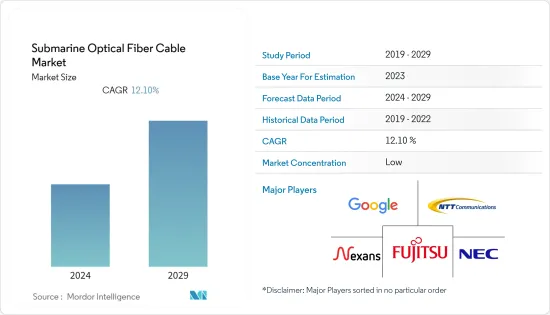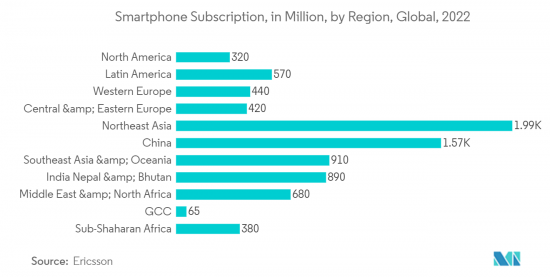 |
市場調查報告書
商品編碼
1404323
海底光纜:市場佔有率分析、產業趨勢與統計、2024-2029 年成長預測Submarine Optical Fiber Cable - Market Share Analysis, Industry Trends & Statistics, Growth Forecasts 2024 - 2029 |
||||||
※ 本網頁內容可能與最新版本有所差異。詳細情況請與我們聯繫。
預計2024年海底光纜市場規模為41.6億美元,預計2029年將達72億美元,在預測期內(2024-2029年)複合年成長率為12.10%。

主要亮點
- 對高速網路基礎設施的投資不斷增加正在推動海底光纜市場的成長。全球海量資料的產生和傳輸持續增加是市場的關鍵促進因素之一。因此,許多網路骨幹業者可能會在預測期內投資海底光纜市場。
- 海底電纜系統承載超過 99% 的洲際通訊流量,是全球互聯互通的無形推動者。在中國和印度等國家的推動下,區域通訊業在全球範圍內高速發展。然而,網路基礎設施仍然是世界許多地區的關鍵問題。
- 世界新興市場的許多人已經可以連接到網際網路,這可能是加強有線網路的下一步。因此,包括政府機構在內的許多公司都將海底光纜市場視為機會。
- 行動寬頻的快速普及對市場成長做出了重大貢獻。有幾個因素正在增加全球對智慧型手機的需求,包括可支配收入的增加、5G 的出現以及通訊基礎設施的改善。例如,根據 GSMA 的數據,全球智慧型手機訂閱量預計將從 2022 年佔總連線數的 76% 增加到 2030 年的 92%。
- 海底電纜塗有矽膠,並包裹有多層陡電線、塑膠、銅鞘套、尼龍線和聚乙烯絕緣層,以保護這些光纖免受損壞,但仍確保安全性和壽命。為了確保這一點,定期維護是需要,這是昂貴的。高安裝成本和維護成本預計將成為市場成長的挑戰。
- 此外,衛星通訊投資的增加也是限制研究市場成長的主要因素。電纜僅適用於短程途徑,尤其是在交通擁擠時。然而,隨著距離的增加和密度的降低,衛星在經濟上變得有吸引力。此外,與任何其他無線部署一樣,擁有衛星通訊鏈路比部署海底電纜要快得多,這是衛星通訊相對於海底光纜的另一個關鍵優勢。
海底光纜市場趨勢
智慧型手機普及與網路頻寬需求增加推動市場
- 近年來,智慧型手機產業經歷了前所未有的成長。除了數位科技的接受度和普及不斷提高之外,企業的行動優先方法也是推動智慧型手機普及的主要因素。愛立信預計,全球智慧型手機用戶數量預計將從 2022 年的 64.2 億增加到 2028 年的 77.4 億。
- 在電子商務這樣的商業環境中,隨著您的業務成長,嘗試同時造訪您網站的流量和人數也會增加,容納這種負載所需的頻寬也會增加。預計這些綜合因素將在預測期內推動市場成長。
- 儘管已開發國家的智慧型手機產業日益成熟,但新興國家仍存在巨大的成長機會。例如,根據愛立信的數據,東北亞(2022年為19.9億)將在智慧型手機用戶方面領先,其次是中國(15.7億)和東南亞和大洋洲(9.1億)。
- 所有這些因素都對所研究的市場做出了貢獻,因為智慧型手機訂閱數量的增加對網際網路消費和資料生成產生積極影響,推動了對資料中心和其他數位基礎設施的需求,其中高頻寬連接是關鍵要求。對生長發育產生正面影響
- 擴展的頻寬、超低延遲和高速連接將擴展文明、徹底改變產業並從根本上改善日常體驗。電子醫療、連網車輛和運輸系統以及先進的行動雲端遊戲曾經被認為是未來主義。
- 頻寬需求通常每年都會顯著增加。這種成長趨勢在依賴串流視訊服務等高負載服務的網路中尤其明顯。隨著串流影音服務擴大提供 4K 視訊內容,遊戲平台正朝著首先提供新遊戲下載的方向發展。像 Google Stadia 這樣的服務現在已經準備好以串流媒體服務的形式分發遊戲。因此,始終存在更高頻寬服務的趨勢。

跨太平洋地區預計將引領市場
- 海底電纜承載著全球 97% 以上的網路流量,幾乎每個人都使用網路進行日常業務。由於網路能夠連接世界各地的人們,國際流量每天都在增加。跨太平洋佔全球網路總流量的很大一部分,推動了對海底通訊電纜的需求。然而,一些國家沒有海底通訊電纜系統,因此世界銀行和亞洲開發銀行正在資助新的電纜系統。
- 人力資源在網路上花費的時間不斷增加也為所研究市場的成長創造了良好的前景。例如,根據日本內務部,日本每個工作日在行動裝置上使用網路的時間已從 2016 年的 61.3 分鐘增加到 2022 年的 113.3 分鐘。
- 此外,數位服務的日益普及和對更快網路連線的需求也推動了該地區的支持措施。例如,2022 年 2 月,根據 Team Telecom 的建議,FCC核准了太平洋光纜網路 (PLCN) 系統的海底電纜登陸授權。從美國到台灣和菲律賓的 PLCN 連接現已投入商業性服務。 Team Telecom 是 Google LLC 及其子公司 GU Holdings Inc.、Meta Platforms Inc.(前身為 Facebook Inc.)和子公司 Edge Cable Holdings USA LLC 保護太平洋光纜網路 (PLCN) 系統上的資料。此海底光纜系統將連接美國、台灣和菲律賓。由此,Team Telecom 獲得了 FCC 授予的 PLCN 系統的 Google 和 Meta 電纜登陸授權。
- 同樣,2022 年 7 月,NTT Ltd Japan Corporation、Mitsui &、PC Landing Corp. 和 JA Mitsui Leasing Ltd 成立,負責建造和營運連接日本和美國的新型、最大的跨太平洋海底電纜系統 JUNO。宣布成立新公司Seren Juno Network (Seren)。
- 在不斷成長的需求和政府支持前景的推動下,供應商正在合作開發全部區域的海底電纜網路,這也支持了所研究市場的成長。例如,2022年8月,NEC公司宣布Seren Juno Network已選擇該公司建造JUNO電纜系統,這是一條連接美國加州與美國千葉縣和三重縣的跨太平洋海底光纜。該電纜全長超過10,000公里,預計2024年終完工。
海底光纜產業概況
海底光纜市場較為分散,主要參與者包括 Google LLC (Alphabet Inc.)、NEC Corporation、Nexans SA、Fujitsu Ltd 和 NTT Communications。市場上的供應商正在採取聯盟、合併、創新和收購等策略來增強其產品陣容並獲得永續的競爭優勢。
- 2023 年 4 月——包括中國電信集團公司、中國移動有限公司和中國聯通在內的中國國有電信業者在亞洲、歐洲和中東之間推出價值 5 億美元的海底光纖網際網路連接,以與美國支持的類似網路競爭計劃。我們正在開發有線網路。該電纜名為「EMA」(歐洲-中東-亞洲),計劃連接香港和中國海南省,然後連接新加坡、巴基斯坦、沙烏地阿拉伯、埃及和法國等國家。
- 2022 年 11 月 - 普睿司曼與三星 C&T 簽署了一項 2.2 億歐元(2 億歐元)的協議,作為與 Jan De Nul 的 EPC 財團的一部分,該計劃據稱是第一個高電壓直流(HVDC -VSC) 海底聯盟。該公司正在建造一個由四個 XLPE 絕緣 HVDC 320kV 單芯電纜和一個光纖電纜系統組成的對稱整體系統,以連接阿布扎比海岸附近阿拉伯灣的 Al Garan 人工島與 Al Mirfa 陸上換流站。設計、供應、組裝和測試桿系統。
其他福利
- Excel 格式的市場預測 (ME) 表
- 3 個月的分析師支持
目錄
第1章簡介
- 研究假設和市場定義
- 調查範圍
第2章調查方法
第3章執行摘要
第4章市場洞察
- 市場概況
- 產業吸引力-波特五力分析
- 供應商的議價能力
- 買方議價能力
- 新進入者的威脅
- 替代品的威脅
- 競爭公司之間的敵對關係
- 產業價值鏈分析
- 宏觀趨勢對產業的影響
第5章市場動態
- 市場促進因素
- 智慧型手機的普及和對網路頻寬的需求增加
- 新興地區光纖連接的增加
- 市場挑戰
- 維護成本上升,衛星通訊投資增加
第6章市場區隔
- 按地區
- 跨太平洋
- 跨大西洋橫渡
- 美國-拉丁美洲
- 亞洲境內
- 歐洲-亞洲
- 歐洲-撒哈拉以南非洲
第7章競爭形勢
- 公司簡介
- Google LLC(Alphabet inc.)
- NEC Corporation
- Nexans SA
- Fujitsu Ltd
- NTT Communications Corporations
- Huwaei Marine Networks Co.
- PT Communication Cable System Indonesia TBK
- LS Cable & System Ltd
- Alcatel Submarine Networks Ltd
- SubCom LLC
- Sumitomo Electric Industries Ltd
- Prysmian SpA
- JDR Cable Systems(Holdings)Ltd
第8章投資分析
第9章市場的未來

The Submarine Optical Fiber Cable Market size is estimated at USD 4.16 billion in 2024 and is expected to reach USD 7.2 billion by 2029, growing at a CAGR of 12.10% during the forecast period (2024-2029).
Key Highlights
- Growing investment in high-speed internet infrastructure is driving the growth of the submarine optical fiber cable market. The continuous increase in the generation and transfer of vast amounts of data worldwide is one of the primary drivers of the market. Hence, many internet backbone operators may invest in the submarine optical fiber cable market over the forecast period.
- Submarine cable systems carry over 99% of intercontinental communication traffic, making them the invisible enabler of global connectivity. The regional telecom industry is advancing at a higher rate worldwide, led by countries like China and India. However, internet infrastructure is still a significant issue in many parts of the world.
- As more and more people in developing areas of the world already have access to the internet, the next step in strengthening the cable network may be in emerging markets worldwide. Hence, many companies, including government agencies, see the submarine optical fiber cable market as an opportunity.
- The rapid increase in mobile broadband penetration significantly contributes to the market's growth. The global demand for smartphones has been increasing due to several factors, like increasing disposable income, the advent of 5G, and the development of telecom infrastructure. For instance, according to GSMA, smartphone subscriptions worldwide is anticipated to grow from 76 percent of total connections in 2022 to 92 percent by 2030.
- Although submarine cables are covered in silicon gel and wrapped in multiple layers of steep wires, plastic, copper sheathing, nylon yarn, and polyethylene insulator to protect these optical fibers from damage, periodic maintenance is still necessary to ensure their safety and longevity, which is expensive. The high installation and maintenance costs are expected to challenge the market's growth.
- Furthermore, the growing investment in satellite communications is another major factor challenging the studied market's growth, as cables only have an advantage over short paths, especially if traffic is heavy. However, satellites become economically more attractive as distance increases and density decreases. Additionally, having a satellite communication link is much faster, as with the other wireless deployments, than deploying submarine cables, which is another significant advantage of satellite communications over submarine optical fiber cables.
Submarine Optical Fiber Cable Market Trends
Growing Smartphone Penetration and Increasing Demand for Internet Bandwidth Drive the Market
- The smartphone industry has witnessed unprecedented growth in recent years. The growing acceptance and prevalence of digital technologies, along with the mobile-first approach of companies, are among the major factors driving smartphone adoption. According to Ericsson, the global number of smartphone subscribers is expected to reach 7,740 million in 2028, from 6,420 million in 2022.
- In a business environment such as e-commerce, as the business grows, the traffic or number of people trying to access the website at once increases as well, driving the amount of bandwidth required to accommodate this load. All these combined factors are expected to drive the market's growth during the forecast period.
- Although the smartphone industry is approaching maturity in developed countries, emerging regions still offer huge growth opportunities. For instance, according to Ericsson, Northeast Asia was the leading region in terms of the number of smartphone subscribers (1,990 million in 2022), followed by China (1,570 million) and Southeast Asia & Oceania (910 million).
- All these factors positively contribute to the growth of the market studied, as a higher smartphone subscription positively impacts internet consumption and the amount of data being generated, driving the demand for data centers and other digital infrastructures wherein high bandwidth connectivity is a crucial requirement.
- Increased bandwidth, ultra-low latency, and faster connectivity are expanding civilizations, revolutionizing industries, and radically improving day-to-day experiences. E-health, networked vehicles and traffic systems, and advanced mobile cloud gaming were formerly considered futuristic.
- Bandwidth demands typically grow significantly every year. These growth trends are more likely for networks that rely on services involving heavy workloads, such as streaming video services. As streaming video services have a growing number of 4K video content, gaming platforms are moving toward delivering new games first by download. Now, services such as Google Stadia are poised to deliver games as a streaming service. Hence, there is a constant trend toward higher bandwidth services.

Trans-Pacific Region is Expected to Lead the Market
- Submarine cables carry over 97% of all internet traffic worldwide, and nearly everyone uses the internet for daily tasks. Due to the internet's ability to connect people worldwide, international traffic is growing daily. Trans-Pacific accounts for a significant portion of all internet traffic worldwide, which is increasing the demand for submarine communication cables. However, some countries' lack of submarine communication cable systems has prompted the World Bank and the Asia Development Bank to fund new cable systems.
- The increasing time people spend on the internet also creates a favorable outlook for the growth of the studied market. For instance, according to the Japanese Ministry of Internal Affairs and Communications, the average time spent by people using the internet via mobile devices per weekday in Japan had increased to 113.3 minutes in 2022, compared to 61.3 in 2016.
- Furthermore, the growing penetration of digital services and demand for faster internet connectivity are also driving supportive initiatives in the region. For instance, in February 2022, as per the recommendations of Team Telecom, the FCC approved a Submarine Cable Landing License for the Pacific Light Cable Network (PLCN) system. PLCN connections from the United States to Taiwan and the Philippines are now in service commercially. Team Telecom entered the National Security Agreements with Google LLC and its subsidiary G.U. Holdings Inc. Meta Platforms Inc. (formerly Facebook Inc.) and subsidiary Edge Cable Holdings USA LLC protect data on the Pacific Light Cable Network (PLCN) system. This undersea fiber optic cable system will connect the United States, Taiwan, and the Philippines. Consequently, Team Telecom has FCC grant Google and Meta cable landing licenses for the PLCN system.
- Similarly, in July 2022, NTT Ltd Japan Corporation, Mitsui & Co. Ltd., PC Landing Corp., and JA Mitsui Leasing Ltd announced the launch of a new company, Seren Juno Network Co. Ltd (Seren), which was founded to construct and operate JUNO, the new and largest Trans-Pacific submarine cable system that will run between Japan and the United States.
- Driven by the growing demand and a supportive government outlook, vendors are collaborating to develop submarine cable networks across the region which is also supporting the studied market's growth. For instance, in August 2022, N.E.C. Corporation announced that Seren Juno Network had selected the company to build a Trans-Pacific subsea fiber-optic cable, JUNO Cable System, connecting California in the United States. with Chiba prefecture and Mie prefecture in Japan. The cable will span over 10,000 km and is expected to complete by the end of 2024.
Submarine Optical Fiber Cable Industry Overview
The submarine optical fiber cable market is fragmented, with the presence of major players like Google LLC (Alphabet Inc.), NEC Corporation, Nexans SA, Fujitsu Ltd, and NTT Communications and Corporation; the growing demand is also attracting new players to the market. Vendors in the market are adopting strategies such as partnerships, mergers, innovations, and acquisitions to enhance their product offerings and gain sustainable competitive advantage.
- April 2023 - Chinese state-owned telecom firms, including China Telecommunications Corporation, China Mobile Limited, and China Unicom, are developing a USD 500 million undersea fiber-optic internet cable network that would link Asia, Europe, and the Middle East to rival a similar project backed by the United States. Named "EMA" (Europe-Middle East-Asia), the proposed cable is planned to link Hong Kong to China's island province of Hainan before making its way to countries such as Singapore, Pakistan, Saudi Arabia, Egypt, and France.
- November 2022 - Prysmian signed a EUR 220 million (USD 234.50 million) limited notice to proceed with Samsung C&T as part of its EPC consortium with Jan De Nul for the project, which is said to be the Middle East's first-of-its-kind high-voltage, direct current (HVDC-VSC) subsea power transmission system. The company will design, supply, assemble, and test a symmetrical monopole system made up of four HVDC 320 kV single-core cables with XLPE insulation, as well as fiber optic cable systems, to connect the Al Mirfaonshore converter station to the Al Ghallanartificial island in the Arabian Gulf off the coast of Abu Dhabi.
Additional Benefits:
- The market estimate (ME) sheet in Excel format
- 3 months of analyst support
TABLE OF CONTENTS
1 INTRODUCTION
- 1.1 Study Assumptions and Market Definition
- 1.2 Scope of the Study
2 RESEARCH METHODOLOGY
3 EXECUTIVE SUMMARY
4 MARKET INSIGHTS
- 4.1 Market Overview
- 4.2 Industry Attractiveness - Porter's Five Forces Analysis
- 4.2.1 Bargaining Power of Suppliers
- 4.2.2 Bargaining Power of Buyers
- 4.2.3 Threat of New Entrants
- 4.2.4 Threat of Substitutes
- 4.2.5 Intensity of Competitive Rivalry
- 4.3 Industry Value Chain Analysis
- 4.4 Impact of Macro Trends on the Industry
5 MARKET DYNAMICS
- 5.1 Market Drivers
- 5.1.1 Growing Smartphone Penetration and Increasing Demand for Internet Bandwidth
- 5.1.2 Increasing Fiber Connectivity in Emerging Regions
- 5.2 Market Challenges
- 5.2.1 Higher Maintenance Costs and Growing Investment in Satellite Communication
6 MARKET SEGMENTATION
- 6.1 By Geography
- 6.1.1 Trans-Pacific
- 6.1.2 Trans-Atlantic
- 6.1.3 US-Latin America
- 6.1.4 Intra-Asia
- 6.1.5 Europe-Asia
- 6.1.6 Europe-Sub-Saharan Africa
7 COMPETITIVE LANDSCAPE
- 7.1 Company Profiles
- 7.1.1 Google LLC (Alphabet inc.)
- 7.1.2 NEC Corporation
- 7.1.3 Nexans SA
- 7.1.4 Fujitsu Ltd
- 7.1.5 NTT Communications Corporations
- 7.1.6 Huwaei Marine Networks Co.
- 7.1.7 PT Communication Cable System Indonesia TBK
- 7.1.8 LS Cable & System Ltd
- 7.1.9 Alcatel Submarine Networks Ltd
- 7.1.10 SubCom LLC
- 7.1.11 Sumitomo Electric Industries Ltd
- 7.1.12 Prysmian SpA
- 7.1.13 JDR Cable Systems (Holdings) Ltd













